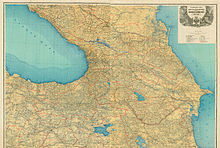
Summary
The Transcaucasian Commissariat was established at Tbilisi on 11 November 1917, as the first government of the independent Transcaucasia following the October Revolution in Petrograd. The Commissariat decided to strengthen the Georgian–Armenian–Azerbaijani union by convoking a Diet or general assembly (Sejm) in January 1918.[1][2] It declared independence from Soviet Russia and formed the Transcaucasian Democratic Federative Republic after being faced with the threat of being overrun by the Ottoman invasion.[3]
| Transcaucasian Commissariat Закавказский Комиссариат Zakavkazskij Komissariat | |||||||||
|---|---|---|---|---|---|---|---|---|---|
| Autonomous area of Russia | |||||||||
| 1917–1918 | |||||||||
 | |||||||||
| Capital | Tiflis (now Tbilisi) | ||||||||
| Government | |||||||||
| • Type | Commissariat | ||||||||
| Chairman | |||||||||
• 1917–1918 | Evgeni Gegechkori | ||||||||
| History | |||||||||
• Established | 11 November 1917 | ||||||||
| 22 April 1918 | |||||||||
| |||||||||

Decline edit
Peace talks were initiated with the Ottoman Empire in March 1918, but broke down quickly as the Ottoman officials refused to accept the authority of the Commissariat. The Treaty of Brest-Litovsk, which ended Russia's involvement in the First World War, conceded parts of the Transcaucasus to the Ottoman Empire, who continued their invasion of the region in order to take control of the territory. Faced with this imminent threat, the TDFR was proclaimed as an independent state on 22 April 1918. Further negotiations began immediately with the Ottoman, which recognized the state.
See also edit
- Special Transcaucasian Committee (OZaKom, Ozakom).
- Transcaucasian Democratic Federative Republic (TDFR, ZKDFR).
References edit
- ^ Richard Pipes, The formation of the Soviet Union, page 103.
- ^ Swietochowski, Tadeusz (1985). Russian Azerbaijan, 1905–1920: The Shaping of a National Identity in a Muslim Community. United Kingdom: Cambridge University Press. p. 106. ISBN 0-521-26310-7. Retrieved July 9, 2010.
- ^ Kenez, Peter (2004). Red Attack, White Resistance; Civil War in South Russia 1918. Washington, DC: New Academia Publishing. pp. 240–241. ISBN 9780974493442.


